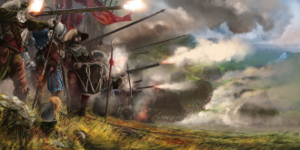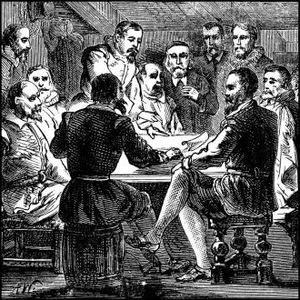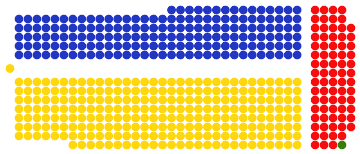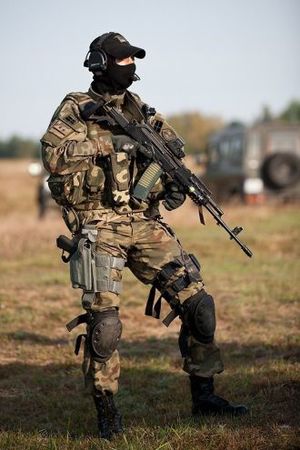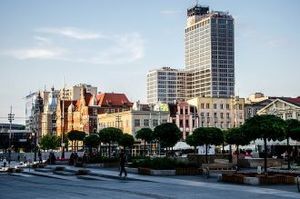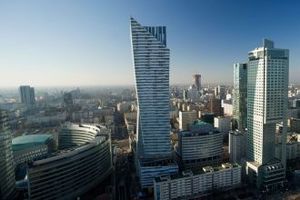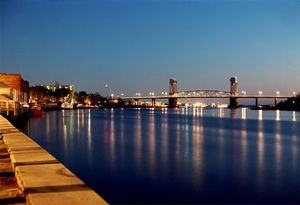New Gandor
Greater Republic of New Gandor Nowy Gąsior | |
|---|---|
|
Flag | |
Motto: "Dla Większej Republiki
" Jackian: "For the Greater Republic" | |
 | |
| Capital | New Union City (Nowy Unia) |
| Largest city | Iornbarron (Żelaznybaron) |
| Official languages | Gandorian |
| Ethnic groups |
|
| Religion |
|
| Demonym(s) | New Gandorian |
| Government | Stratocratic republic |
| Jacek Sekorsky | |
| Alexi Torvsk | |
| Pyeter Kobiet | |
| History | |
| 362 B.C. | |
| 452 C.E. | |
| February 22, 1710 | |
| Population | |
• (2019 estimate) estimate | 172 million |
| GDP (nominal) | 2019 - 2023 estimate |
• Total | 9.03 trillion caps (4th) |
• Per capita | 42,000 caps (9th) |
| Gini (2022) | low |
| HDI (2022) | very high |
| Currency | New Gandorian Cap (NCP) |
| Time zone | AMT+10,+11,+12,+13 |
| Driving side | right |
| Calling code | 602 |
| Internet TLD | .ng |
New Gandor (Gandorian: Nowy Gąsior), officially the Greater Republic of New Gandor (Gandorian: Wielka Republika Nowy Gąsior) is the southernmost nation on the continent of Ostlandet. It is bordered to the south, east, and west by ocean, to the north by Gjorka and Ajakanistan. New Gandor's capital city is ‘’’New Union City’’’, (Gandorian: Nowy Unia) but ‘’’Iornbarron’’’, (Gandorian: Żelaznybaron) is considered the largest in the country. New Gandor is one of the original founding members of the Terraconserva Council of Nations. New Gandor is also a member of The Ostlandet Union and ROKO.
New Gandor's earliest founding goes back to the formation of Gandora around 170 B.C. and was partitioned between the Siemion and Grycz Empires around 145 A.D. It was re-founded in the year 510 A.D. as a result of the Great Divide. The Kingdom of Gandora was founded in the wake of the great divide around 560 A.D. It expanded to its current borders in 1220 A.D. forming the Commonwealth of Gandor. The Commonwealth was a loosely associated system with lords controlling the provinces, and the king at the center. The system fell apart in 1471 A.D. and power was consolidated to the king. In 1660 a civil war broke out between Nationalists and Royalists. The civil war lasted forty four years and concluded with the creation of the Greater Republic. In 1710 a Constitution was created on the foundations of fairness, defense to the nation, mercantilism, and faith in Christ. New Gandor is currently allied with Creeperopolis, Gjorka, Monsilva, Paleocacher, and Pavulturilor. New Gandor is also the protector of The Republic of Rotorua. The current leader is President Jacek Sekorsky.
Contents
History
Early History
The earliest records of New Gandor date back to Gandora which was a tribe of early Aversentian speaking peoples, around 170 B.C. banding together with like minded goals and ideals. Other villages and tribes around Gandora banded together to form kingdoms and defensive pacts. Quickly two empires rose conquering their neighbors, these being the Siemion Empire ruled by King Jonatan Siemion in the east, and the Grycz Empire ruled by King Ludomir Grycz in the west.
In 142 A.D, the empires sought to divide Gandora and made an agreement partitioning Gandora between themselves. The tribe fought for its independence but was defeated in 145 A.D. and divided. The Gandoran’s were subjected to servitude and forced into a lower class for resisting.
In 223 A.D. Grycz and Siemion declared war on each other with the lands of Gandora being the first battle grounds. The war lasted five years with the Siemion Empire defeating and conquering Grycz in 228 A.D. A serfdom was established with the Siemion’s ruling all other classes. Lavish spending and wars in the north led to turmoil in the kingdom and the fracture of the Siemion Empire in 560 A.D, also known as the Great Divide. All former lands vied to claim and rule the empire's lands, with the freed peoples of Gandora forming The Kingdom of Gandora in 564 A.D. led by their own elected king, King Lech Gąsior. In 570 A.D. The Kingdom of Gandora looked to expand. This resulted in a series of border wars and skirmishes on the island of Te Punga between what is modern Gjorka and New Gandor. The split of the island between Gjorkan and Gandorian rule. The Gandorian side was declared the island state of Rotorua, developing the Rotoruan culture.
In 1115 A.D, the kingdom looked to create a commonwealth between the fractured peoples of the former empire. By 1220 A.D, The Kingdom of Gandora united the fractured empire under the banner of King Włodzisław Jeśko. The five tribes decided to name the new union The Commonwealth of Gandor, with the five heads of each tribe advising and counseling the elected king. Two hundred years later the system fell to ruin when power was consolidated and the council dismissed. Kajetan Tyraniec the current king declared himself true king of the commonwealth, King Ambroży Kret Tyraniec I. Thus establishing the Tyran line in 1471 A.D. Around this time the Creeperian Catholic Church in Gandor was established alongside the Tryaniec regime.
Middle History
Once at the center of the commonwealth King Ambroży Kret Tryaniec I began to suppress the peoples, including those from his own village, gaining the name Ambroży the Tyrant among the people. Positions of power were distributed between Tryaniec’s inner circle Two factions loosely formed with those favoring the king, and the other named the nationalists. The nationalists continued to be punished harshly with the execution of rivals by the Tryaniec regime. The most horrific act came in 1620, known as the Tears of Seresyt. The village of Seresyt, a village that openly opposed the king, was massacred and burned down by the king's army.
The growing unrest boiled over into an all out conflict in 1660, where vast numbers of musketeers and pikemen from the king’s army defected and fled east to defend their families. In the same year the commonwealth was split into two. With the nationalists in the east, taking up the name the Easterners or Mieszkańcy Wschodu, while the Royalists took the west. Fighting broke out in September 1660 A.D. with the battle of Keilce Plains, where the Easterners ambushed a column of royal pikemen, routing them. The commonwealth was enveloped in a civil war. Due to pike and shot warfare, cannons, cavalry, and shifting tactics, the bloodshed throughout the country was great. The bloodiest was the The Battle of New Union. Out of the entire male population of the commonwealth over one third died in a span of a week during the battle. The battle ended with the siege of Tryaniec where Easterners breached the walls of the Tryaniec castle and routed the forces inside. King Aleksander Tryaniec II was forced to abdicate the throne and cede power to the Easterners. A treaty was struck between the Easterners and Royalists. The main points being the pardon of all royalist soldiers and citizens, and the exile of Aleksander Tryaniec and the royal family. Over the fourty year conflict (1660-1704), close to half the male population of Gandor died. During this time the island of Rotorua sided with the Easterners, seeing them as an avenue towards independence.
This conflict also saw the beginning of New Gandor's separation from the Creeperian Catholic Church. During the civil war Father Szymon Witowski began a movement away from the Creeperian Catholic Church seeing it as an avenue of the corruption that brought New Gandor to civil war. Witowski formed The Gandorian Protestant Church or Wschódism after the Easterners that brought about the change for Gandor's benefit. As a part of the treaty with the Royalists, the Creeperian Catholic Church was allowed to remain in Gandor, but couldn't regain its former influence.
From 1704 to 1710 the Easterners began the reconstruction era, beginning with the integration and unification of all villages. The peoples came together and called the new nation New Gandor, symbolizing the fresh start for the country. In 1706 it was decided to draft a constitution and officialize the creation of this new nation. Each of the villages sent one representative each to gather in the drafting. Four years of debate, bargaining, and compromise produced the 1st and current Constitution of New Gandor. While debating it was concluded that a republic was the best direction for the country in which true and loyal patriots, entrusted by the citizenry, would lead the state. Thus the military was entrusted to forge each citizen into a prime example and test their true hearts. Mandatory military service was established in the constitution additionally, seeing the need for strength in the nation. In this a stratocratic element was woven into each the executive and legislature. It is written “those who wish to serve in the halls of executive leadership, or lead in legislative diplomacy must serve the country in (military) service.” This was added to ensure the loyalty, and pride of the nation would survive, no matter how harsh the storm or foe, internal or external. The judiciary was left untouched by the military seeing that justice needed to remain unbiased from all influences. It is written “Any citizen who upholds the law in the form of selflessness and an unbiased manner through the judicial system is exempt from military service.” It was believed that those who were born with the heart and mind to uphold all laws without grudges or bias, were already patriots and could not be shaken. In 1710 the constitution was ratified and implemented to all the regions, with the stratocratic-republic form of government being approved, officially forming The Greater Republic of New Gandor. The capital of the country was set in New Union in 1712, as a symbol of tradition and peace between the royalists and easterners.
Late History
First elections for the new nation were held in 1714 with three parties being formed in the decades following. Those that embraced full democratic ideals, sought to improve welfare and other ideas under the umbrella of human rights, centralize power, and expand alliances across the known world formed the Unia Party in 1730. Those that sought to withhold tradition, bolster the military, encourage a free market, and give rights to the provinces formed the Republika Party (New Gandor) in 1730. Later a party of those in between formed, feeling neutral, and wanting to fortify New Gandor formed the Niezależny Party in 1890. Other minor parties have existed over time, but have either been absorbed or exiled in the case of the Gandorian People's Party. New Gandor at this time also expanded it's horizons to the continent of Ostlandet forming alliances with neighbor Gjorka and later world power Paleocacher in the late 1800s. The rise of communist ideologies saw dissension rise within New Gandor and the rise of the People's Party of New Gandor or the PLNG. Around 1900 the party gained a small following, and signs of unrest by these people were beginning.
Around 1903 the PLNG started to levy protests. They cited the greater republic was just as corrupt as the Tyran Commonwealth. They sought to put the power in the hands of the people and to wipe New Gandor clean of the greedy elites. The protesters were anything but peaceful. Buildings were burned, people of different ideologies killed. From 1905 - 1910 or The Years of Red saw clashes between the Government and communists, bordering a second civil war. A resentment among the non communist peoples began, and petitions to the government to permanently fix the situation were levied. The Unia Party sought to find common ground and make amends with the PLNG. While the Republika and Niezależny Parties sought to end the insurgency. With the election of 1910 the Republika party was in power. President Fryderyk Czepic ordered the exile of all communists from New Gandor. Kongres quickly affirmed the order, with the opposition coming from the PLNG and some of the Unia Party. From 1910-1912 all communist party members were tracked, interrogated, stripped of their Gandorian citizenship, and exiled out of the country. Celebrations and parades were held in all major cities. This wasn't without consequences however, the Unia Party saw an upshift in membership due to the families that were affected removing themselves from the other parties. The Unia Party held majority party status in Kongres from 1914-1918. In 1918 the Republika Party took majority party status running on anti-communist ideals. Members of the Unia Party and other leftist parties that supported the PLNG were allowed to keep their Gandorian Citizenship, however were exiled to Rotorua in the finaly days of these events. In 1921, the Gandorian government passed the Rotorua Act giving the island self-governing status within New Gandor. Upholding the promise given to the Rotoruans back in the late 1600s. A unitary parliamentary republic was set up and guided by New Gandor and in 1939 official independence was signed. In return for a peaceful release, New Gandor was allowed to maintain a naval base in Nowy Lublin, and received full protection from the Gandorian government and military.
Modern History
The anti-communist sentiment found allies across the Alathlasiu and Southern Oceans in Creeperopolis and Pavulturilor. The Creeperian Civil War began in 1933 seeing clashes between the National Council and Imperial Council. New Gandor joined the war in 1942 sending soldiers and armored vehicles to fight alongside the Imperial Council against the Miguelists. The 17th Infantry Division commanded by Major General Krystian Matulewicz consisted of 30,000 soldiers. It saw most of its service in San Salvador and San Luís. The 17th Infantry Division served in Creeperopolis until the end of the civil war, returning to New Gandor in late-1949. New Gandor continued to grow relations with Creeperopolis and joined the Anti-Communism Treaty. New Gandor was also one of the founding members of the Terraconserva Council of Nations. As of the late 1900s and 2000s New Gandor continues it's alliances with Creeperopolis, Gjorka, Paleocacher, and Pavulturilor. New Gandor has been involved in the San Carlos Islands Crisis, the OU military intervention in Ajakanistan, and other conflicts upholding a sense of duty to protect Ostlandet. New Gandor is also a founding member of the Ostlandet Union.
Government
Overview
New Gandor is a republic, but with a few minor differences. There is a republican component and a stratocratic component. In the republican part there is a unicameral legislature, a supreme court, and an executive branch. There is a system of checks and balances in place to ensure no one branch overtakes the other. Officials are elected on a term basis, save a few appointed positions. The stratocratic part comes into play by military involvement in each branch, excluding the Judaical branch. The military officials in each branch are there to advise, not limit, or oppress the processes of each branch.
Legislature
New Gandor unlike other republics and democracies has a unicameral legislature called Kongres. Its is the job of the legislature to write up, edit, and vote on laws, confirm presidential appointments, declare war, and make a national budget. They also have the power to investigate the executive, and judicial branch within reasonable cause.
The stratocratic element comes into play with the Legislative Military Attache. It is their job to advise the legislature on current military actions and issues, as well as weigh in on declarations of war.
Executive
Like most other democracies and republics the executive branch is headed by the President, the Presidents Cabinet, and the Vice President. It is the job of the executive to implement and enforce laws created by the legislature. The President has the ability to veto bills, appoint justices to the Supreme Court, and all other justices, as well as ambassadors to other countries. The President is also the leader of the New Gandorian Armed Forces, and is head ambassador. The President also has the power to pardon, and create treaties with other nations.
The stratocratic element is built into the executive with the presidents role as Commander in Chief, as well as the cabinet position of Sectary of War.
Judiciary
The job of the Judiciary is to interpret laws, settle legal disputes, punish violators, hear civil cases, protect individual rights granted by the constitution, determine guilt or innocence in federal crimes, and interpret the constitution.
There is no stratocratic element in the Judiciary.
Geography
New Gandor is divided into 5 provinces. New Union (home of New Union City), Obfity (home of Iornbarron), Centralny, Nizinny, and Erie. New Union is hilly with some flat lands, with a portion of the Unia Mountians. Obfity has a small mountian chain as well as hills and flat lands. Centraly contains most of the Unia Mountians and some hills. Nizinny is hilly with some flat lands. Finally Erie holds the Zimana cliffs over looking ocean.
Economy
The New Gandorian economy is primarily manufacturing based. Leading this area is Arms Manufacturing with notable companies FB "Łucznik" Radom, Bumar-Labedy, and General Dynamics. The next notable Manufacturing areas are martime vessels, leaders Bath Iron Works, and Swan Hunter, machining tools and manufacturing tools, like cnc machines, turning machines (lathes and boring mills), shapers and planers, drilling machines, milling machines, grinding machines, power saws, and presses, with leader Gleason, farm equipment, leader Jon Deerski, medical equipment manufacturing, leader Stryker, and automobiles, leader Jeep.
Behind manufacturing is mining, most notably iron ore. In house forging turns this into steel to be shipped and used. Notable mining companies are Żelazo Mining and notable forging companies are Unia Forge.
A few other companies are part of the economy. A notable one being Under Armor.
Military
Currently in the New Gandorian Armed Forces there are 2.52 million service men and women. There are 3 branches consisting of army, navy, and air force. There is also a special forces branch called Rosomak. Approximately 6% of the New Gandorian budget goes towards the military, seen as a deterrent through strength and numbers to avoid conflict. All able body men are required to serve a minimum of 3 years starting at age 18. After this they can choose to make a military career or become reserve. All reserve personal up to age 45 can be called into service again in the event of a draft. Women are not conscripted and have a choice in joining the military.
This is the break down of personnel.
- Active Personnel - 1.5 Million
- Rosomak: 20,000
- National Guard (Ostatnia Milicja) - 1 Million.
The Gandorian Military is currently involved in the San Carlos Islands Crisis
List of Gandorian Military Equipment
List of Gandorian Medals and Merits
Diplomacy
New Gandor has good diplomatic and trade ties with the members of the Ostlandet Union since its it's inception. New Gandor has very strong diplomatic ties with Paleocacher, and Gjorka. Also few diplomatic and trade ties with Quebecshire. New Gandor also has really strong military ties with Creeperopolis working closely with them since 1938 and Pavulturilor as of recent world events.
Demographics
There are five regions inside New Gandor. They are Nowy Unia (home of New Union City), Obfity (home of Iornbarron), Centralny, Nizinny, and Eire.
East New Gandor is more urban with some rural areas, while West New Gandor is vise versa.
New Union City
New Union City is located in the New Union Province. It is the capital city of New Gandor. It has residential, buinensess, and governmental districts throughout. It is home to the Presidental House, Convention Plaza (seen in the picture as the tallest building in back), Rosomak HQ, and other governmental buildings. It is also home to Under Armor Arena
Iornbarron
Iornbarron is located in the Obfity Province of New Gandor. It is seen as the Architectural and Engineering marvel of New Gandor. Iornbarron is the largest city in New Gandor. It is home to General Dynamics HQ, FB "Łucznik" Radom HQ, and others. It is also home to New Gandor's largest business district, and The Iglica (Spire) (The largest building seen in the picture)
Fort Handel
Fort Handel is located in the Eire Province of New Gandor. It is a major trading city and is nicknamed 'the vein of New Gandor'. It is considered the first city travelers from the west see, on boat or plane. It is home to Trader's Pass and New Gandor's largest naval base. It also houses the HQs for Bath Iorn Works, Swan Hunter, and other naval companies.

